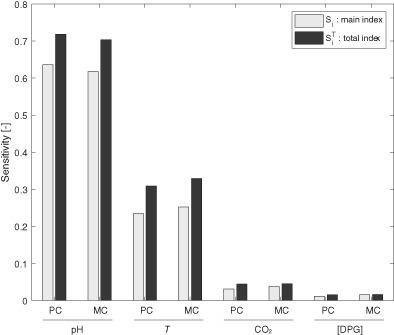当前位置:
X-MOL 学术
›
Int. J. Numer. Method. Biomed. Eng.
›
论文详情
Our official English website, www.x-mol.net, welcomes your
feedback! (Note: you will need to create a separate account there.)
Efficient sampling for polynomial chaos-based uncertainty quantification and sensitivity analysis using weighted approximate Fekete points.
International Journal for Numerical Methods in Biomedical Engineering ( IF 2.2 ) Pub Date : 2020-08-13 , DOI: 10.1002/cnm.3395 Kyle M Burk 1, 2 , Akil Narayan 3, 4 , Joseph A Orr 1, 2
International Journal for Numerical Methods in Biomedical Engineering ( IF 2.2 ) Pub Date : 2020-08-13 , DOI: 10.1002/cnm.3395 Kyle M Burk 1, 2 , Akil Narayan 3, 4 , Joseph A Orr 1, 2
Affiliation

|
Performing uncertainty quantification (UQ) and sensitivity analysis (SA) is vital when developing a patient‐specific physiological model because it can quantify model output uncertainty and estimate the effect of each of the model's input parameters on the mathematical model. By providing this information, UQ and SA act as diagnostic tools to evaluate model fidelity and compare model characteristics with expert knowledge and real world observation. Computational efficiency is an important part of UQ and SA methods and thus optimization is an active area of research. In this work, we investigate a new efficient sampling method for least‐squares polynomial approximation, weighted approximate Fekete points (WAFP). We analyze the performance of this method by demonstrating its utility in stochastic analysis of a cardiovascular model that estimates changes in oxyhemoglobin saturation response. Polynomial chaos (PC) expansion using WAFP produced results similar to the more standard Monte Carlo in quantifying uncertainty and identifying the most influential model inputs (including input interactions) when modeling oxyhemoglobin saturation, PC expansion using WAFP was far more efficient. These findings show the usefulness of using WAFP based PC expansion to quantify uncertainty and analyze sensitivity of a oxyhemoglobin dissociation response model. Applying these techniques could help analyze the fidelity of other relevant models in preparation for clinical application.
中文翻译:

使用加权近似 Fekete 点对基于多项式混沌的不确定性量化和灵敏度分析进行有效采样。
在开发特定于患者的生理模型时,执行不确定性量化 (UQ) 和灵敏度分析 (SA) 至关重要,因为它可以量化模型输出的不确定性并估计模型的每个输入参数对数学模型的影响。通过提供这些信息,UQ 和 SA 充当诊断工具来评估模型保真度并将模型特征与专家知识和现实世界观察进行比较。计算效率是 UQ 和 SA 方法的重要组成部分,因此优化是一个活跃的研究领域。在这项工作中,我们研究了一种用于最小二乘多项式近似、加权近似 Fekete 点 (WAFP) 的新有效采样方法。我们通过证明其在估计氧合血红蛋白饱和度响应变化的心血管模型的随机分析中的效用来分析该方法的性能。在对氧合血红蛋白饱和度建模时,使用 WAFP 的多项式混沌 (PC) 扩展在量化不确定性和识别最具影响力的模型输入(包括输入交互)方面产生了类似于更标准的蒙特卡罗的结果,使用 WAFP 的 PC 扩展效率更高。这些发现表明使用基于 WAFP 的 PC 扩展来量化不确定性和分析氧合血红蛋白解离反应模型的敏感性的有用性。应用这些技术可以帮助分析其他相关模型的保真度,为临床应用做准备。在对氧合血红蛋白饱和度建模时,使用 WAFP 的多项式混沌 (PC) 扩展在量化不确定性和识别最具影响力的模型输入(包括输入交互)方面产生了类似于更标准的蒙特卡罗的结果,使用 WAFP 的 PC 扩展效率更高。这些发现表明使用基于 WAFP 的 PC 扩展来量化不确定性和分析氧合血红蛋白解离反应模型的敏感性的有用性。应用这些技术可以帮助分析其他相关模型的保真度,为临床应用做准备。在对氧合血红蛋白饱和度建模时,使用 WAFP 的多项式混沌 (PC) 扩展在量化不确定性和识别最具影响力的模型输入(包括输入交互)方面产生了类似于更标准的蒙特卡罗的结果,使用 WAFP 的 PC 扩展效率更高。这些发现表明使用基于 WAFP 的 PC 扩展来量化不确定性和分析氧合血红蛋白解离反应模型的敏感性的有用性。应用这些技术可以帮助分析其他相关模型的保真度,为临床应用做准备。这些发现表明使用基于 WAFP 的 PC 扩展来量化不确定性和分析氧合血红蛋白解离反应模型的敏感性的有用性。应用这些技术可以帮助分析其他相关模型的保真度,为临床应用做准备。这些发现表明使用基于 WAFP 的 PC 扩展来量化不确定性和分析氧合血红蛋白解离反应模型的敏感性的有用性。应用这些技术可以帮助分析其他相关模型的保真度,为临床应用做准备。
更新日期:2020-08-13
中文翻译:

使用加权近似 Fekete 点对基于多项式混沌的不确定性量化和灵敏度分析进行有效采样。
在开发特定于患者的生理模型时,执行不确定性量化 (UQ) 和灵敏度分析 (SA) 至关重要,因为它可以量化模型输出的不确定性并估计模型的每个输入参数对数学模型的影响。通过提供这些信息,UQ 和 SA 充当诊断工具来评估模型保真度并将模型特征与专家知识和现实世界观察进行比较。计算效率是 UQ 和 SA 方法的重要组成部分,因此优化是一个活跃的研究领域。在这项工作中,我们研究了一种用于最小二乘多项式近似、加权近似 Fekete 点 (WAFP) 的新有效采样方法。我们通过证明其在估计氧合血红蛋白饱和度响应变化的心血管模型的随机分析中的效用来分析该方法的性能。在对氧合血红蛋白饱和度建模时,使用 WAFP 的多项式混沌 (PC) 扩展在量化不确定性和识别最具影响力的模型输入(包括输入交互)方面产生了类似于更标准的蒙特卡罗的结果,使用 WAFP 的 PC 扩展效率更高。这些发现表明使用基于 WAFP 的 PC 扩展来量化不确定性和分析氧合血红蛋白解离反应模型的敏感性的有用性。应用这些技术可以帮助分析其他相关模型的保真度,为临床应用做准备。在对氧合血红蛋白饱和度建模时,使用 WAFP 的多项式混沌 (PC) 扩展在量化不确定性和识别最具影响力的模型输入(包括输入交互)方面产生了类似于更标准的蒙特卡罗的结果,使用 WAFP 的 PC 扩展效率更高。这些发现表明使用基于 WAFP 的 PC 扩展来量化不确定性和分析氧合血红蛋白解离反应模型的敏感性的有用性。应用这些技术可以帮助分析其他相关模型的保真度,为临床应用做准备。在对氧合血红蛋白饱和度建模时,使用 WAFP 的多项式混沌 (PC) 扩展在量化不确定性和识别最具影响力的模型输入(包括输入交互)方面产生了类似于更标准的蒙特卡罗的结果,使用 WAFP 的 PC 扩展效率更高。这些发现表明使用基于 WAFP 的 PC 扩展来量化不确定性和分析氧合血红蛋白解离反应模型的敏感性的有用性。应用这些技术可以帮助分析其他相关模型的保真度,为临床应用做准备。这些发现表明使用基于 WAFP 的 PC 扩展来量化不确定性和分析氧合血红蛋白解离反应模型的敏感性的有用性。应用这些技术可以帮助分析其他相关模型的保真度,为临床应用做准备。这些发现表明使用基于 WAFP 的 PC 扩展来量化不确定性和分析氧合血红蛋白解离反应模型的敏感性的有用性。应用这些技术可以帮助分析其他相关模型的保真度,为临床应用做准备。











































 京公网安备 11010802027423号
京公网安备 11010802027423号